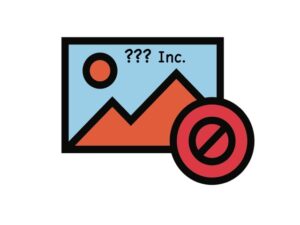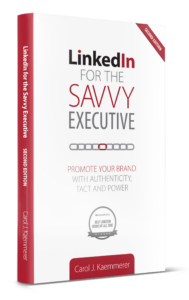A Small Omission That Undermines
Your Credibility on LinkedIn

Time and again we hear that people come to conclusions about others in a matter of seconds – and they do so based on very small cues. Therefore, when communicating our brand online, paying attention to the “little things” is quite important. One of the little things that packs a huge negative wallop to our eminence is the absence of a logo in our Experience, Education and Volunteer sections. This is an issue on many executive profiles. In this article I discuss:
- how the absence of a logo can be interpreted
- remedies for the lack of a logo for a company over which you have control
- remedies to missing logos where the logo exists within LinkedIn’s database
- some strategies to explore if the logo is not in the database
How is the Absence of a Logo Interpreted?
The absence of a logo is always negative, but it is most damaging if the missing logo is for your current role with a company for which you are among the top executives (e.g., Owner, Founder, President, CEO, Principal Consultant, etc.). For example, if you are the founder of a company but your LinkedIn profile shows no associated company logo, it may be interpreted that you have a hobby rather than a real business – that you are not serious about your endeavor. Simply put, this error is a primary way that senior executives undermine their own credibility. But if you have made this error, it is totally within your power to fix it. (More on that later.)
Another interpretation people may reach when there are job positions and other entries in one’s LinkedIn profile that do not have associated logos that is that the person is either careless or clueless. If the appropriate logo exists within the LinkedIn database but it is not shown on the person’s profile, either of those assumptions may be correct. Of course, there are situations where there is no logo shown because no logo exists in the LinkedIn database. This can happen if the company is currently out of business or if it is too small to have bothered to create a Company Page and therefore have a logo within the LinkedIn database.
No Logo – and You Control the Company
The good news is that you are in control here. With very little effort you can fix this situation, thereby removing the impression that you have a hobby rather than a real business. The reason that your logo is not showing up is that you need to create a LinkedIn Company Page for your business. When you create a page for your company, you upload the company logo to LinkedIn’s database, making it available to display not only on the Company Page but also on your profile and on the profiles of all employees and board members.
To create a LinkedIn Company Page, you need:
- a company website
- an email address that goes to your company’s domain, and you have associated that email address with your LinkedIn account
- a logo (a square image, at least 60 x 60 pixels in size, in JPEG or PNG file format)
See directions for setting up your company page here.
When you have created your Company Page and uploaded the logo, you and other employees need to delete the company name from your profile, then you can immediately re-enter it, selecting your company’s name and logo from a dropdown menu. The logo will then show up on your profile. The result – everyone associated with the company will be appropriately branded – a huge win LinkedIn makes available without charge.
By the way, once you have created your Company Page, you need not do anything else with it. It will not become a burden on your time. On the other hand, you could use it as an additional way to amplify your online brand.
Remedies to Missing Logos – Where the Logo Exists Within LinkedIn’s Database
Some of the reasons the logo is not appearing on a profile might be:
- the company/organization’s name is misspelled or entered incorrectly (for example, searching for The Ohio State University under “Ohio” doesn’t work because the university’s name is The Ohio State University)
- the company/organization’s name has changed
If you’re not sure how to spell the company name or of the company’s current moniker, search for it on Google. When you’re sure, then delete the company/organization name from your profile and re-enter the name correctly, selecting the company’s name and logo from the dropdown menu LinkedIn will provide.
Strategies to Explore If the Logo Is Not in LinkedIn’s Database
Some absent logos can be addressed by finding the logo of the company/organization’s parent group, then adding the Division or Chapter with which you are associated in the job title line. For example, suppose you were a member of the board of directors for the local chapter of a national charity. You might find that several local chapters have Company Pages on LinkedIn, but the chapter with which you are associated does not. In this case, on the company/organization line of your LinkedIn profile entry for your board of directors experience, enter the national charity and its logo. But to not be misleading, since you were not on the board of the national charity, on the line with your role, list “Board of Directors for the [name of the chapter].”
If the company you worked for is no longer in business but was acquired by another company, list the current name of the (acquiring) company. If there is sufficient space, in your job title line, note in parentheses (formerly [name of company when you worked there)]. If there isn’t enough room for that in your job title, add that information to the first line of your description of the job.
Of course, some companies just won’t have logos. You’ll just have to do without them. But by making sure you’ve claimed all the logos you can, you will minimize the toll that the lack of logos can take on your personal eminence.
Savvy executives pay attention to their LinkedIn profiles. They know that even small things – like logos – are important to the way others perceive them.
 If you are a C-Suite executive or senior leader who would like to improve your LinkedIn profile and presence, I can make it easy for you. I have a track record of working effectively with C-Suite executives and senior leaders to create LinkedIn profiles and other executive-branded materials that help them show up as authentically and powerfully online as they do in person. I also mentor clients on LinkedIn etiquette and effective posting strategies to ensure their success. Contact me through my website: www.carolkaemmerer.com or profile: www.linkedin.com/in/carolkaemmerer.
If you are a C-Suite executive or senior leader who would like to improve your LinkedIn profile and presence, I can make it easy for you. I have a track record of working effectively with C-Suite executives and senior leaders to create LinkedIn profiles and other executive-branded materials that help them show up as authentically and powerfully online as they do in person. I also mentor clients on LinkedIn etiquette and effective posting strategies to ensure their success. Contact me through my website: www.carolkaemmerer.com or profile: www.linkedin.com/in/carolkaemmerer.
Other resources for you and your team:
For a virtual or in-person presentation on personal branding via LinkedIn, contact me. I am a member of the National Speakers Association, a Certified Virtual Presenter, and an Advisor to the C-Suite Network.
My NEW book Second Edition: LinkedIn for the Savvy Executive: Promote Your Brand with Authenticity, Tact and Power is available through online booksellers. For a quantity discount or signed copies, contact me directly.
To receive my monthly articles in your email inbox, sign up for my monthly emailing here.





















